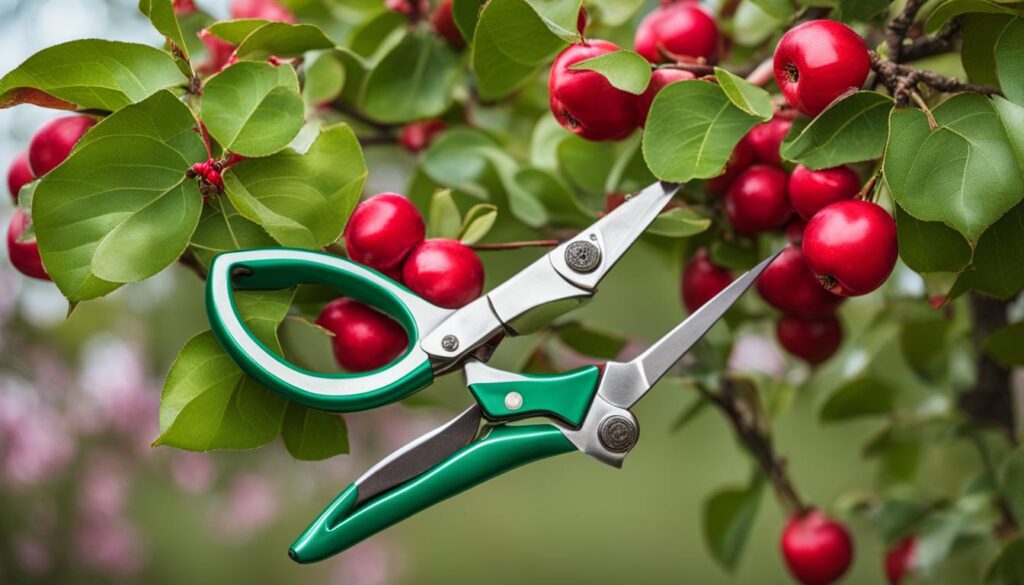Pruning crabapple trees is essential for promoting healthy growth and vibrant blossoms. By removing dead branches and maintaining a proper shape, you can ensure the overall health and appearance of your tree. But when is the best time to prune?
The ideal time for pruning crabapple trees is during the later winter or early spring, when the tree is dormant. This is before new leaves have emerged, allowing for easier pruning without interfering with the tree’s growth. It is recommended to wait until after the first killing frost of the season to ensure dormancy.
Pruning during the dormant season also minimizes the risk of infection and disease spread. Additionally, removing dead or diseased branches helps the tree allocate resources for new growth and keeps it aesthetically pleasing.
To achieve the best results when pruning your crabapple tree, use proper pruning tools such as pruning secateurs. These will enable clean cuts and reduce the risk of damage to the tree. Remember to remove suckers, which are small shoots that emerge near the base of the tree, year-round to maintain a healthy structure.
By following the recommended pruning practices and timing, you can optimize the health and beauty of your crabapple tree, allowing it to thrive and produce vibrant blossoms.
How to Prune Crabapple Trees
When it comes to pruning your crabapple trees, there are several important steps to follow in order to maintain their health and structure. By removing dead branches, water sprouts, and maintaining the proper shape, you’ll help your trees flourish and thrive.
1. Removing suckers and water sprouts: Start by identifying any suckers that grow from the rootstock and water sprouts that can increase the risk of disease spread. These should be pruned off to prevent any potential harm to the tree’s overall health.
2. Removing dead branches: Look for any dead branches and cut them at the base to ensure they are fully removed. This will not only improve the aesthetics of your tree but also prevent any potential disease or infection from spreading.
3. Maintaining the tree’s structure: To prevent overcrowding and ensure a pleasing shape, remove any crossing branches entirely. You may also want to consider removing branches that are growing too close together. Additionally, thin out lower branches that could impede movement under the tree.
4. Limiting aesthetic pruning: While it’s tempting to engage in extensive aesthetic pruning, it’s important to keep it to a minimum. Excessive pruning can trigger the growth of water sprouts, which may compromise the structure and long-term health of the tree.
By following these steps, you’ll be able to prune your crabapple trees effectively, ensuring their vigor and longevity. Remember, maintaining the structure and health of your trees is key to enjoying their beauty for years to come.
Dealing with Diseases and Maintenance
Crabapple trees are susceptible to various diseases, with fire blight being a particularly common and serious bacterial infection. This disease primarily affects new leaves and flowers, compromising the tree’s health and vitality. To prevent the spread of fire blight, it is crucial to identify and remove affected branches along with the parent stem if necessary.
In addition to fire blight, it is essential to regularly inspect your crabapple tree for other common diseases such as scabs, rust, and powdery mildew. If any branches show signs of these diseases, promptly remove them at the collar, ensuring complete elimination. Regular inspection and timely action can help maintain the overall health of your crabapple tree.
When pruning to address diseases, it is important to disinfect your pruning tools between cuts. This practice helps prevent the spread of pathogens from one branch to another, reducing the risk of disease transmission. Using disinfectants suitable for gardening tools can effectively eliminate pathogens and safeguard the health of your tree.
Maintaining a healthy crabapple tree involves a holistic approach. While pruning plays a significant role in disease prevention, it is important to avoid excessive pruning, which can have detrimental effects on the tree’s growth. Striking the right balance between maintaining the tree’s structure and promoting healthy growth is key to maintaining a vibrant and disease-resistant crabapple tree.
Summary:
- Fire blight is a common bacterial infection that affects crabapple trees, particularly new leaves and flowers.
- Remove branches showing signs of fire blight, along with the parent stem, to prevent disease spread.
- Regularly inspect your tree for other diseases like scabs, rust, and powdery mildew, and remove affected branches at the collar.
- Disinfect pruning tools between cuts to prevent disease transmission.
- Maintain a healthy crabapple tree by avoiding excessive pruning that can hinder its growth.
Conclusion
Pruning crabapple trees is an essential part of their care routine. By regularly removing dead branches, water sprouts, and maintaining proper structure, you can promote the overall health and appearance of your crabapple tree. Pruning should be done during the dormant season, typically in late winter or early spring, when the tree is not actively growing. This helps promote healthy growth and vibrant blossoms.
When pruning, make sure to use the appropriate tools, such as pruning secateurs, to ensure clean and precise cuts. Regularly inspect your tree for any signs of diseases, such as fire blight, scabs, rust, or powdery mildew. If any branches are affected, promptly remove them at the collar to prevent the spread of infection.
It’s important to strike a balance between pruning for tree health and aesthetic purposes. While some pruning is necessary to maintain a pleasing shape and prevent overcrowding, excessive pruning can stunt the tree’s growth and trigger an excessive growth of water sprouts. To maintain a healthy crabapple tree, focus on overall tree health and limit aesthetic pruning.
Remember, a well-pruned crabapple tree not only looks beautiful but also contributes to the overall beauty and health of your landscape. By following a proper crabapple tree pruning and care routine, you can enjoy the vibrant blossoms and healthy growth for years to come.
Is the Pruning Schedule for Crabapple Trees Similar to That of Dogwood Trees?
When it comes to pruning dogwood trees, timing is crucial. However, the pruning schedule for crabapple trees differs. Unlike dogwood trees, which are best pruned during late winter or early spring, crabapple trees fare well when pruned during late winter or early summer. Understanding the specific needs of each tree type will ensure optimal growth and health.










